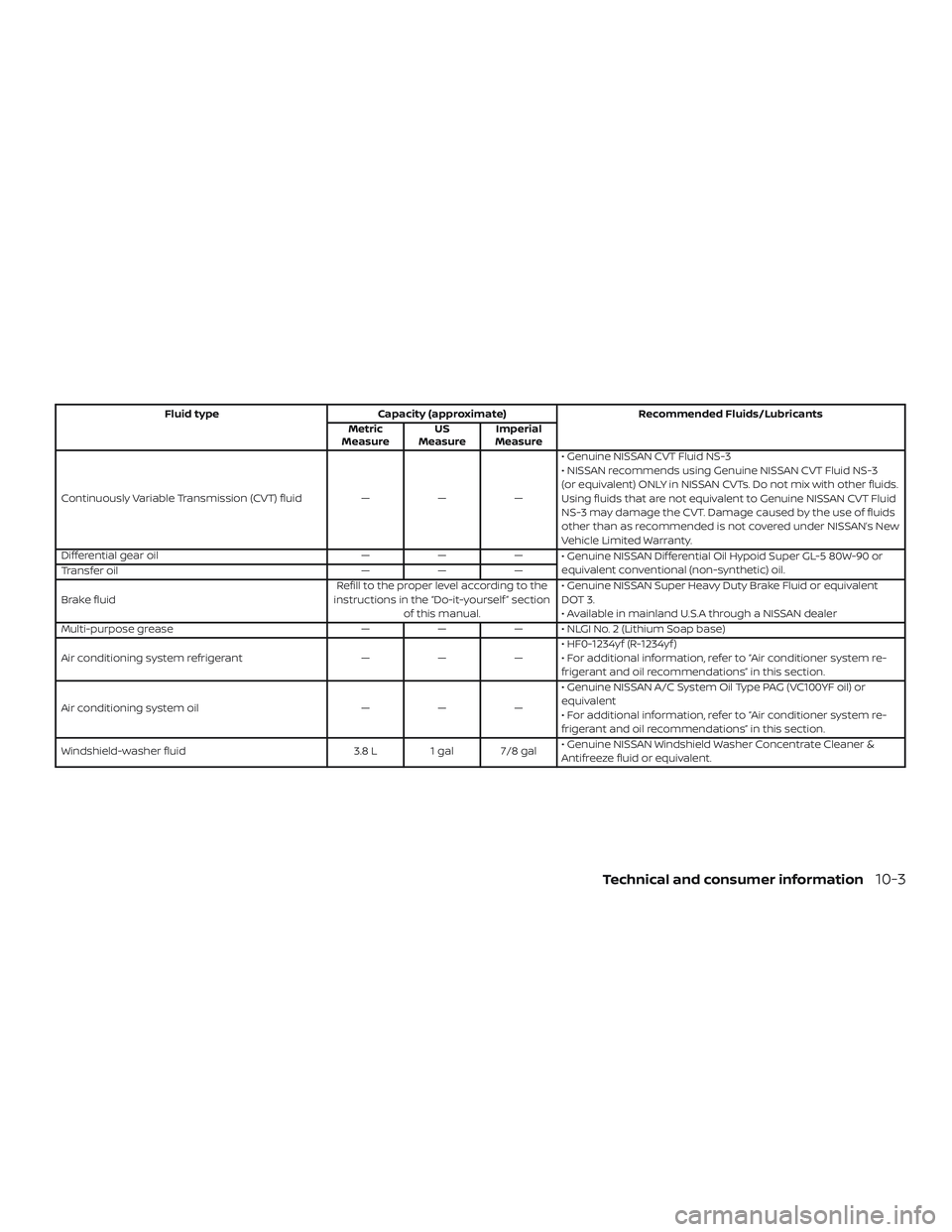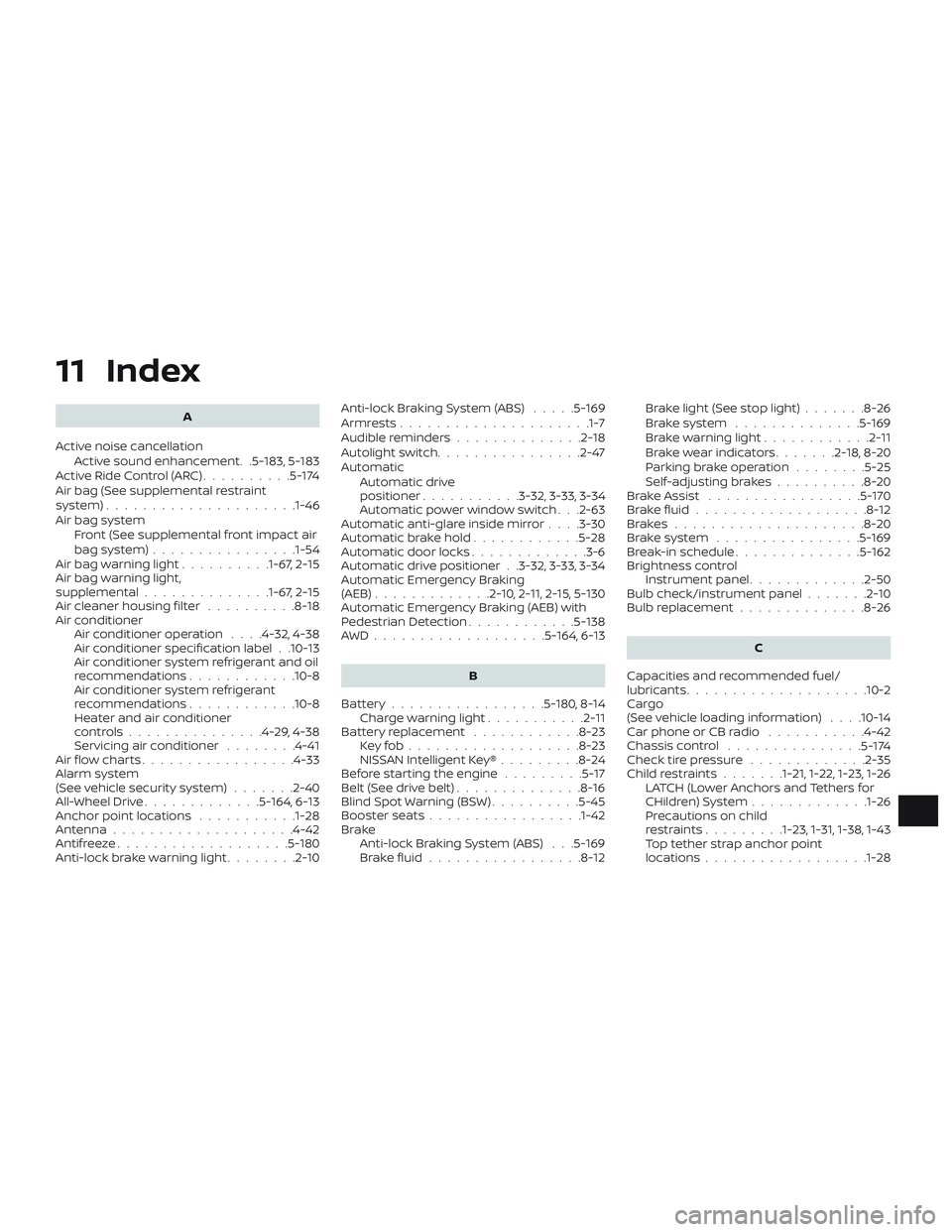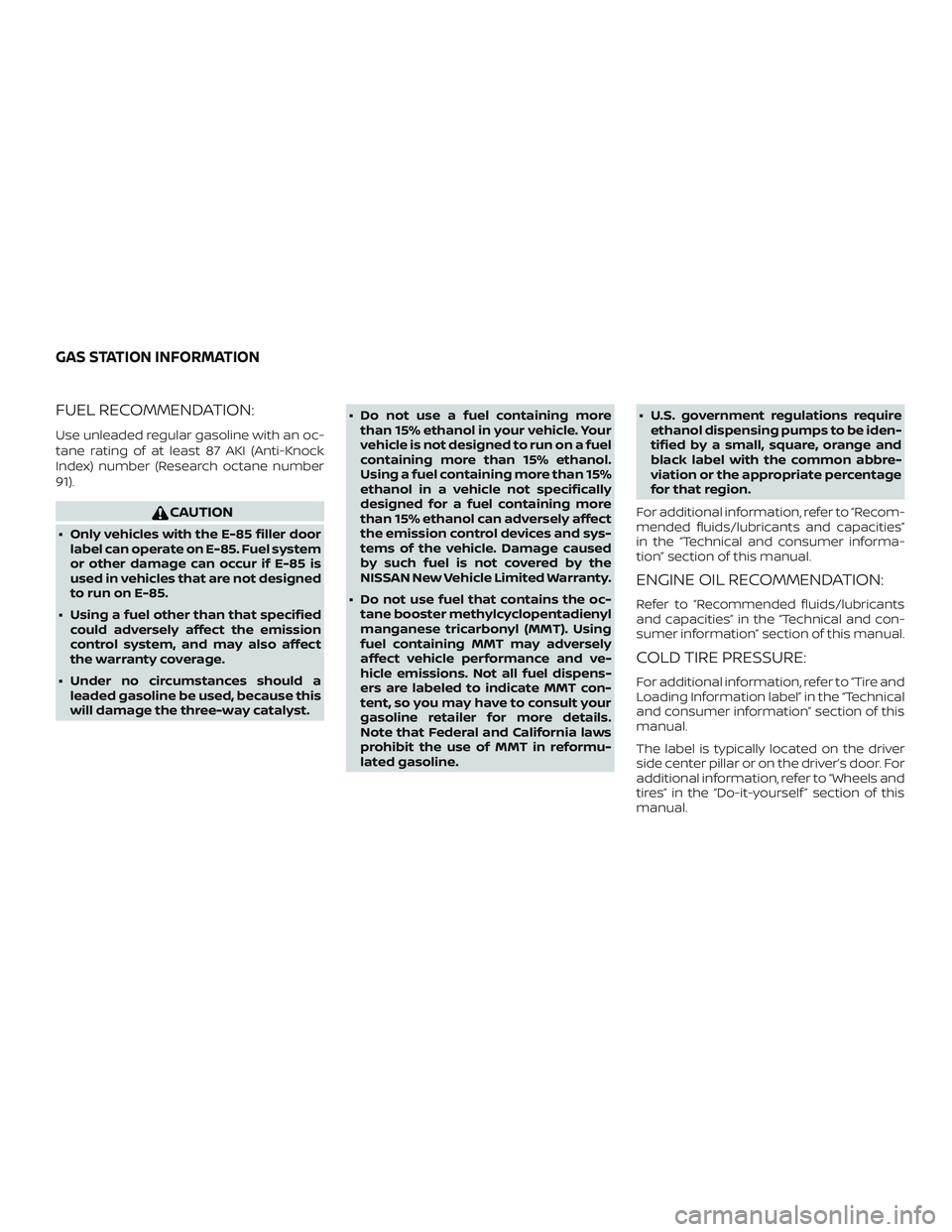2020 NISSAN ALTIMA recommended oil
[x] Cancel search: recommended oilPage 524 of 559

Fluid typeCapacity (approximate) Recommended Fluids/Lubricants
Metric
Measure US
Measure Imperial
Measure
Continuously Variable Transmission (CVT) fluid ———• Genuine NISSAN CVT Fluid NS-3
• NISSAN recommends using Genuine NISSAN CVT Fluid NS-3
(or equivalent) ONLY in NISSAN CVTs. Do not mix with other fluids.
Using fluids that are not equivalent to Genuine NISSAN CVT Fluid
NS-3 may damage the CVT. Damage caused by the use of fluids
other than as recommended is not covered under NISSAN’s New
Vehicle Limited Warranty.
Differential gear oil ———
• Genuine NISSAN Differential Oil Hypoid Super GL-5 80W-90 or
equivalent conventional (non-synthetic) oil.
Transfer oil ———
Brake fluid Refill to the proper level according to the
instructions in the “Do-it-yourself ” section of this manual. • Genuine NISSAN Super Heavy Duty Brake Fluid or equivalent
DOT 3.
• Available in mainland U.S.A through a NISSAN dealer
Multi-purpose grease ——— • NLGI No. 2 (Lithium Soap base)
Air conditioning system refrigerant ———• HF0-1234yf (R-1234yf )
• For additional information, refer to “Air conditioner system re-
frigerant and oil recommendations” in this section.
Air conditioning system oil ———• Genuine NISSAN A/C System Oil Type PAG (VC100YF oil) or
equivalent
• For additional information, refer to “Air conditioner system re-
frigerant and oil recommendations” in this section.
Windshield-washer fluid 3.8 L 1 gal 7/8 gal• Genuine NISSAN Windshield Washer Concentrate Cleaner &
Antifreeze fluid or equivalent.
Technical and consumer information10-3
Page 528 of 559

ENGINE OIL AND OIL FILTER
RECOMMENDATIONS
Selecting the correct oil
It is essential to choose the correct grade,
quality and viscosity engine oil to ensure
satisfactory engine life and performance.
For additional information, refer to “Recom-
mended fluids/lubricants and capacities”
in this section. NISSAN recommends the
use of an energy conserving oil in order to
improve fuel economy.
Select only engine oils that meet the Ameri-
can Petroleum Institute (API) certification orInternational Lubricant Standardization and
Approval Committee (ILSAC) certification
and SAE viscosity standard. These oils have
the API certification mark on the front of the
container. Oils which do not have the speci-
fied quality label should not be used as they
could cause engine damage.
Oil additives
NISSAN does not recommend the use of oil
additives. The use of an oil additive is not
necessary when the proper oil type is used
and maintenance intervals are followed.
Oil which may contain foreign matter or has
been previously used should not be used.
Oil viscosity
The engine oil viscosity or thickness
changes with temperature. Because of
this, it is important to select the engine oil
viscosity based on the temperatures at
which the vehicle will be operated before
the next oil change. Choosing an oil viscos-
ity other than that recommended could
cause serious engine damage.
Selecting the correct oil filter
Your new NISSAN vehicle is equipped with a
high-quality Genuine NISSAN oil filter. When
replacing, use a Genuine NISSAN oil filter or
its equivalent for the reason described in
“Change intervals.”
Change intervals
The oil and oil filter change intervals for your
engine are based on the use of the specified
quality oils and filters. Using engine oil and
filters that are not of the specified quality, or
exceeding recommended oil and filter
change intervals could reduce engine life.
Damage to the engine caused by improper
maintenance or use of incorrect oil and filter
quality and/or viscosity is not covered by the
NISSAN New Vehicle Limited Warranty.
LTI2303
Technical and consumer information10-7
Page 546 of 559

11 Index
A
Active noise cancellation Active sound enhancement. .5-183, 5-183
ActiveRideControl(ARC)..........5-174
Air bag (See supplemental restraint
system) .................... .1-46
Air bag system Front (See supplemental front impact air
bagsystem)............... .1-54
Airbagwarninglight..........1-67, 2-15
Air bag warning light,
supplemental ..............1-67, 2-15
Air cleaner housing filter ..........8-18
Air conditioner Air conditioner operation ....4-32,4-38
Air conditioner specification label . .10-13
Air conditioner system refrigerant and oil
recommendations ............10-8
Air conditioner system refrigerant
recommendations ............10-8
Heater and air conditioner
controls...............4-29,4-38
Servicing air conditioner ........4-41
Air flow charts .................4-33
Alarm system
(See vehicle security system) .......2-40
All-Wheel Drive .............5-164,6-13
Anchor point locations ...........1-28
Antenna ....................4-42
Antifreeze ...................5-180
Anti-lock brake warning light ........2-10Anti-lock Braking System (ABS)
.....5-169
Armrests.................... .1-7
Audible reminders ..............2-18
Autolightswitch................2-47
Automatic Automatic drive
positioner ...........3-32,3-33,3-34
Automatic power window switch . . .2-63
Automatic anti-glare inside mirror ....3-30
Automaticbrakehold............5-28
Automatic door locks .............3-6
Automatic drive positioner . .3-32, 3-33, 3-34
Automatic Emergency Braking
(AEB) .............2-10,2 -11, 2-15, 5-130
Automatic Emergency Braking (AEB) with
Pedestrian Detection ............5-138
AWD...................5-164,6-13
B
Battery.................5-180,8-14 Charge warning light ...........2-11
Battery replacement ............8-23
Keyfob...................8-23
NISSAN Intelligent Key® .........8-24
Before starting the engine .........5-17
Belt(Seedrivebelt)..............8-16
Blind Spot Warning (BSW) ..........5-45
Booster seats .................1-42
Brake Anti-lock Braking System (ABS) . . .5-169
Brakefluid.................8-12 Brakelight(Seestoplight).......8-26
Brakesystem ..............5-169
Brakewarninglight............2-11
Brakewearindicators.......2-18,8-20
Parking brake operation
........5-25
Self-adjustingbrakes..........8-20
Brake Assist .................5-170
Brakefluid...................8-12
Brakes.....................8-20
Brakesystem ................5-169
Break-in schedule ..............5 -162
Brightness control Instrument panel .............2-50
Bulb check/instrument panel .......2-10
Bulb replacement .............. 8-26
C
Capacities and recommended fuel/
lubricants....................10-2
Cargo
(See vehicle loading information) . . . .10-14
Car phone or CB radio ...........4-42
Chassis control ...............
5-174
Check tire pressure .............2-35
Childrestraints.......1-21, 1-22, 1-23, 1-26 LATCH (Lower Anchors and Tethers for
CHildren)System.............1-26
Precautions on child
restraints.........1-23, 1-31, 1-38, 1-43
Top tether strap anchor point
locations..................1-28
Page 547 of 559

Child safety rear door lock..........3-7
Chimes, audible reminders .........2-18
Cleaningexteriorandinterior......7-2,7-5
C.M.V.S.S. certification label .........10-12
Coldweatherdriving ............5-180
Console box ..................2-59
Continuously Variable Transmission
(CVT) .......................5-18
Continuously Variable Transmission
(CVT) fluid ..................8-12
Driving with Continuously Variable
Transmission (CVT) ............5-18
Controls Heater and air conditioner
controls................4-29,4-38
Coolant Capacities and recommended
fuel/lubricants...............10-2
Changing engine coolant .........8-6
Checking engine coolant level ......8-6
Engine coolant temperature gauge . .2-6
Corrosionprotection..............7-8
Cruisecontrol .................5-63
Cupholders ...............2-60,2-61
D
Daytime Running Light System ......2-50
Defroster switch Rear window and outside mirror
defrosterswitch..............2-44
Dimensions and weights ..........10-10
Dimmer switch for instrument panel . . .2-50
Door locks ....................3-4
Drivebelt ....................8-16 Drive positioner, Automatic . . .3-32, 3-33, 3-34
Driving
Cold weather driving ..........5-180
Driving with Continuously Variable
Transmission (CVT) ............5-18
Precautions when starting and
driving..................5-4,5-11
Drivingthevehicle...............5-18
E
E-call (SOS) Button ..............2-54
Economy - fuel ................5-164
Emergency engine shutoff .......5-15,6-2
Emission control information label . . . .10-13
Emission control system warranty . . . .10-19
Engine Before starting the engine ........5-17
Capacities and recommended
fuel/lubricants...............10-2
Changing engine coolant .........8-6
Changing engine oil ............8-8
Changing engine oil filter .........8-8
Checking engine coolant level ......8-6
Checking engine oil level .........8-7
Engine compartment check
locations...................8-3
Engine coolant temperature gauge . .2-6
Engine cooling system ..........8-5
Engine oil ...................8-7
Engine oil and oil filter
recommendation .............10-7
Engine oil pressure warning light ....2-12
Engine oil viscosity .............10-7
Engine serial number ..........10-12 Engine specifications
...........10-9
Starting the engine ............5-17
Engine Block Heater .............5-182
Engine coolant temperature gauge ....2-6
EventDatarecorders.........10-21,10-22
Exhaust gas (Carbon monoxide) .......5-4
Explanation of maintenance items .....9-2
Explanation of scheduled maintenance
items .......................9-5
Extended storage switch ..........2-57
Eyeglasscase.................2-59
F
Flashers
(Seehazardwarningflasherswitch)....6-2
Flattire....................6-3,6-4
Floormatpositioningaid...........7-6
Fluid Brakefluid..................8-12
Capacities and recommended
fuel/lubricants...............10-2
Continuously Variable Transmission (CVT)
fluid......................8-12
Engine coolant ...............8-5
Engine oil ...................8-7
Windshield-washer fluid .........8-13
F
.M.V.S.S. certification label .........10-12
Foglightswitch ................2-51
Front air bag system
(See supplemental restraint system) . . .1-54
Front-door pocket ..............2-58
Front power seat adjustment ........1-4
Frontseats....................1-2
11-2
Page 550 of 559

O
Octane rating (See fuel octane rating) . .10-6
Odometer ....................2-5
Oil Capacities and recommended
fuel/lubricants...............10-2
Changing engine oil ............8-8
Changing engine oil filter .........8-8
Checking engine oil level .........8-7
Engine oil ...................8-7
Engine oil and oil filter
recommendation .............10-7
Engine oil viscosity .............10-7
Outsidemirrors.................3-31
Overhead sunglasses holder ........2-59
Overheat Ifyourvehicleoverheats.........6-11
Owner's manual order form ........10-23
Owner's manual/service manual order
information..................10-23
P
Parking Parking brake operation .........5-25
Parking/parkingonhills.........5-168
Parkingbrake...........2-12,2-16,5-25
Personal lights .................2-67
Power Power door locks ..............3-6
Poweroutlet................2-56
Powerrearwindows...........2-63
Power steering system .........5-168
Powerwindows ..............2-61 Rearpowerwindows...........2-63
Poweroutlet..................2-56
Powersteering................5-168
Precautions Maintenance precautions .........8-2
Precautions on booster
seats............1-23, 1-31, 1-38, 1-43
Precautions on child
restraints .........1-23, 1-31, 1-38, 1-43
Precautions on seat belt usage .....1-12
Precautions on supplemental restraint
system ................... .1-46
Precautions when starting and
driving..................5-4,5-11
ProPILOT Assist ................5-90
Push starting ..................6-11
R
Radio Car phone or CB radio ..........4-42
Readiness for inspection maintenance (I/M)
test .......................10-21
Rear Automatic Braking (RAB) .......5-124
RearCrossTrafficAlert(RCTA) .......5-55
Rear Door Alert .............2-37,2-55
Rearpowerwindows.............2-63
Rearseat.................... .1-5
Rear Sonar System (RSS) ..........5-175
Rearviewmirror................3-30
RearViewMonitor................4-3
Rear window and outside mirror defroster
switch......................2-44
Recommended Fluids ............10-2 Recorders
EventData.............10-21,10-22
Refrigerant recommendation ........10-8
Registering a vehicle in another
country .....................10-11
Remote Engine Start ..........3-19,5-18
Reporting safety defects (US only) . . . .10-20
S
Safety Child safety rear door lock ........3-7
Childseatbelts......1-23, 1-31, 1-38, 1-43
Reporting safety defects (US only) . .10-20
Seat adjustment Front manual seat adjustment ......1-3
Front power seat adjustment ......1-4
Rear seat adjustment ...........1-5
Seatback pockets ...............
2-58
Seat belt Childsafety ................ .1-21
Infants and small children ........1-22
InjuredPerson............... .1-15
Largerchildren.............. .1-22
Precautionsonseatbeltusage.....1-12
Pregnant women ..............1-15
Seat belt extenders ............1-20
Seat belt maintenance ..........1-20
Seatbelts................1-12, 7-7
Shoulder belt height adjustment . . . .1-19
Three-pointtypewithretractor.....1-15
Seat belt extenders ..............1-20
Seatbeltwarninglight.........1-14, 2-15
Seats Adjustment ..................1-2
11-5
Page 556 of 559

FUEL RECOMMENDATION:
Use unleaded regular gasoline with an oc-
tane rating of at least 87 AKI (Anti-Knock
Index) number (Research octane number
91).
CAUTION
∙ Only vehicles with the E-85 filler doorlabel can operate on E-85. Fuel system
or other damage can occur if E-85 is
used in vehicles that are not designed
to run on E-85.
∙ Using a fuel other than that specified could adversely affect the emission
control system, and may also affect
the warranty coverage.
∙ Under no circumstances should a leaded gasoline be used, because this
will damage the three-way catalyst. ∙ Do not use a fuel containing more
than 15% ethanol in your vehicle. Your
vehicle is not designed to run on a fuel
containing more than 15% ethanol.
Using a fuel containing more than 15%
ethanol in a vehicle not specifically
designed for a fuel containing more
than 15% ethanol can adversely affect
the emission control devices and sys-
tems of the vehicle. Damage caused
by such fuel is not covered by the
NISSAN New Vehicle Limited Warranty.
∙ Do not use fuel that contains the oc- tane booster methylcyclopentadienyl
manganese tricarbonyl (MMT). Using
fuel containing MMT may adversely
affect vehicle performance and ve-
hicle emissions. Not all fuel dispens-
ers are labeled to indicate MMT con-
tent, so you may have to consult your
gasoline retailer for more details.
Note that Federal and California laws
prohibit the use of MMT in reformu-
lated gasoline. ∙ U.S. government regulations require
ethanol dispensing pumps to be iden-
tified by a small, square, orange and
black label with the common abbre-
viation or the appropriate percentage
for that region.
For additional information, refer to “Recom-
mended fluids/lubricants and capacities”
in the “Technical and consumer informa-
tion” section of this manual.
ENGINE OIL RECOMMENDATION:
Refer to “Recommended fluids/lubricants
and capacities” in the “Technical and con-
sumer information” section of this manual.
COLD TIRE PRESSURE:
For additional information, refer to “Tire and
Loading Information label” in the “Technical
and consumer information” section of this
manual.
The label is typically located on the driver
side center pillar or on the driver’s door. For
additional information, refer to “Wheels and
tires” in the “Do-it-yourself ” section of this
manual.
GAS STATION INFORMATION